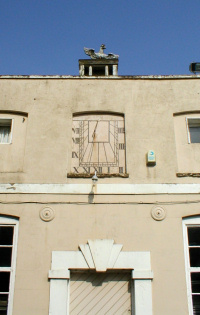Harefield
Harefield, Hillingdon
A large, self-contained village – and a world famous hospital – situated in the far north-western corner of Greater London

Neolithic remains have been found in the parish, as well as fossils in the chalk. Notwithstanding the ‘hare of Harefield’ shown in the picture above, the settlement’s name probably derives from the Old English words here (army) and feld (open space; field). The name may thus allude to an encampment by a Viking army during the Danish invasions of the 10th and early 11th centuries.
St Mary’s church is of 13th-century origin and is noted for its wealth of monuments. During the Middle Ages and 16th century much of the parish consisted of moors and common land, with the cultivated lands of Harefield manor around the village.

The 18th and 19th centuries saw the growth of several estates on which country houses were built, including Belhammonds, also known as Harefield Park, a three-storey, seven-bay mansion dating from the 1710s. Two centuries later it became the orginal home of Harefield Hospital (see below) but now stands disused and in need of restoration. Click here for a Bing bird’s eye view of the mansion.
The construction of the Grand Junction (now Grand Union) Canal on the western side of the parish at the end of the 18th century changed the character of this part of Harefield.
By 1813 limekilns and copper mills lay along the northern part of the canal, and there were coal wharves north of Moorhall. The industrial area continued to expand throughout the century, but away from the canal Harefield remained one of the few places in Middlesex where the ancient pattern of an agricultural village survived into the second half of the 19th century, mainly because of the absence of a main road or railway.
By the outbreak of the First World War houses were being built by the mills, around Hill End, along the main roads and round the village green. Large sand and gravel workings operated on the outskirts of Harefield between the wars but most of these are now disused or have become landfill sites, while much of the canalside industry has been replaced by offices and other business premises.
Uxbridge council built nearly 500 houses between 1919 and 1951 around the common and in Northwood Road, and in South Harefield and Mount Pleasant. Subsequent development, both public and private, has been tightly constrained by the inclusion of almost all the surviving farmland within the green belt.
Harefield village retains a genuinely rural character, though a fifth of its housing is owned by Hillingdon council. The population is 88 per cent white and educational attainment is relatively low. Car ownership is high, as it needs to be out in the sticks.
The story of Harefield Hospital
During the First World War a hospital was established at the mansion latterly known as Harefield Park for the treatment of injured Australians and New Zealanders. Many of those who died at the hospital are buried in the churchyard of St Mary’s Harefield, where they are commemorated by a memorial arch and a granite obelisk.
In the 1930s Harefield became an isolation hospital for tuberculosis patients, laying the foundations of its expertise in lung conditions. In the late 1940s the hospital became part of the new National Health Service and began to develop its expertise in heart disease, in addition to its lung specialisation.
Professor Sir Magdi Yacoub performed Harefield’s first heart transplant in 1980 and the world’s first combined heart and lung transplant in 1983. Since then the hospital has had a distinguished history of ground-??breaking advances, most recently exemplified in its work on ‘artificial hearts’ and minimally invasive procedures. Harefield’s dedicated Heart Attack Centre deals with cardiac emergencies from outer north-west London, and provides one of the fastest arrival-to-treatment times in Europe.
In 1998 Harefield was twinned with another renowned London chest hospital to form the Royal Brompton & Harefield NHS Trust. Plans to incorporate Harefield’s facilities on the site of a new ‘super-hospital’ at Paddington Waterside fell apart in 2005.
Postcode area: Uxbridge UB9
Population: 7,399 (Harefield ward; by far the borough’s smallest ward at the 2011 census)
Further reading: Eileen M Bowlt, Ickenham and Harefield Past, Historical Publications, 1996
and Geoff Hewlett, Harefield, Amberley, 2012
See also: Harefield Grove
